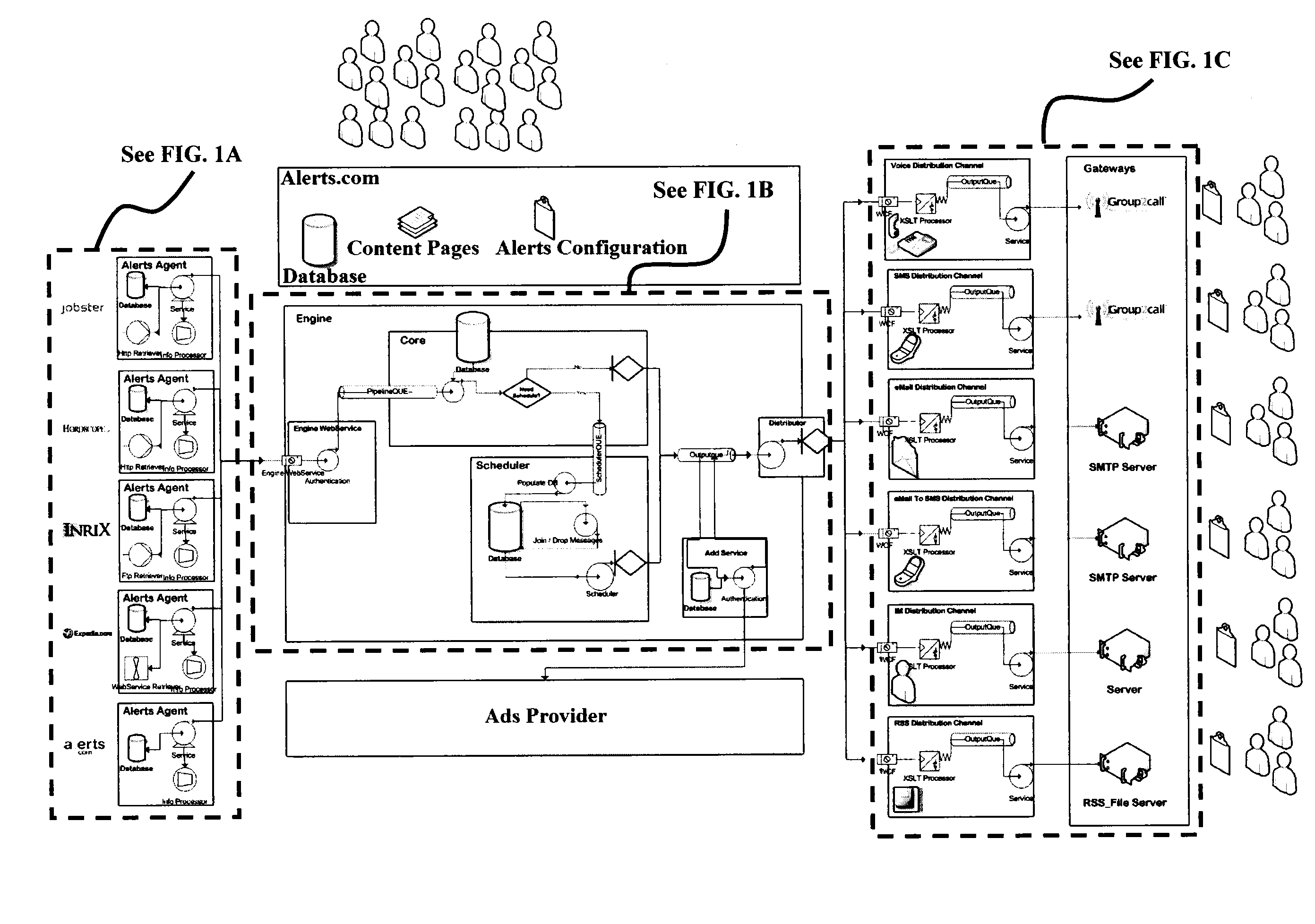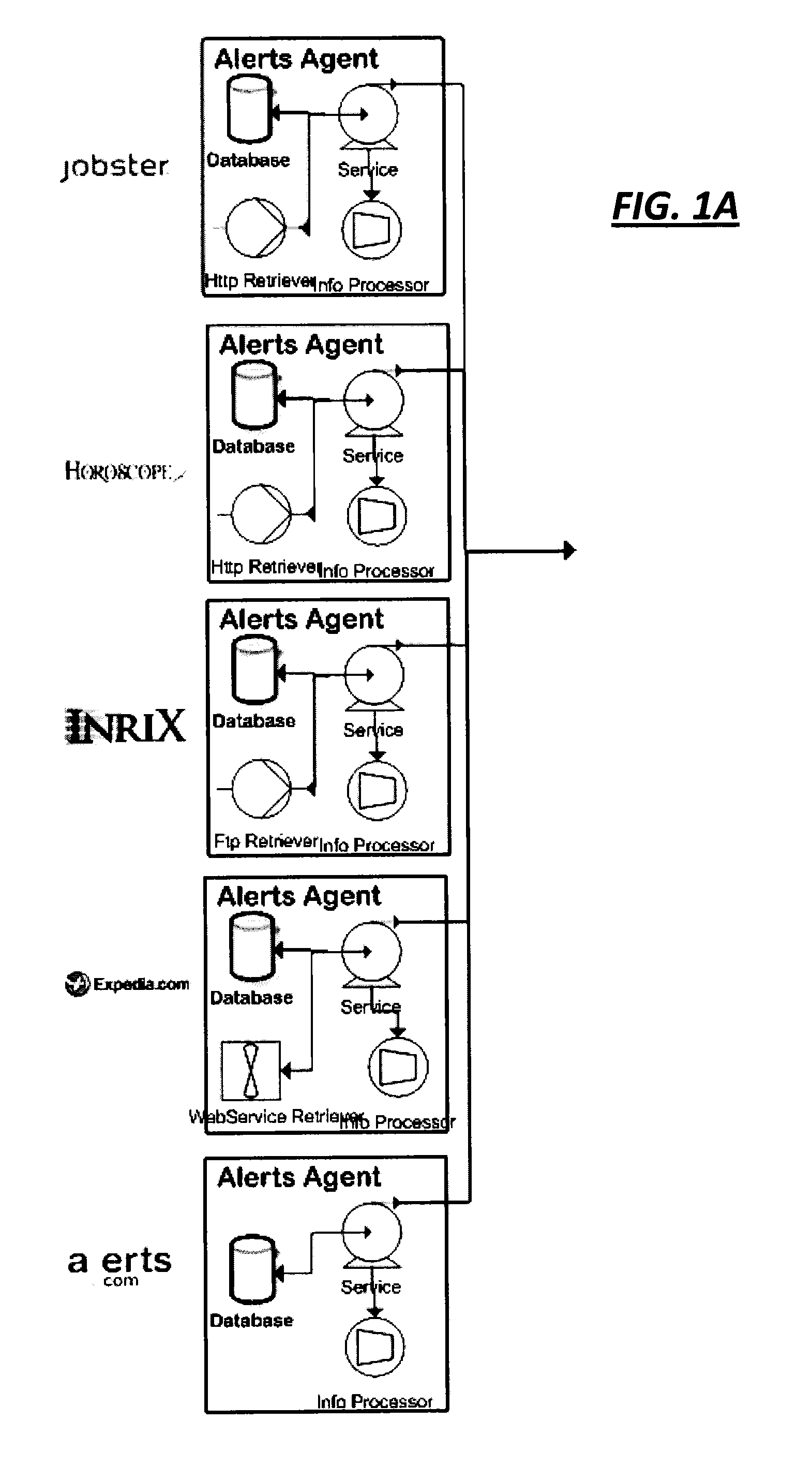The challenges that consumers often experience include the constant need to make repeated searches in order to identify relevant content or to sort through pre-aggregated content (e.g.
RSS feeds) to identify the presence of any information pertinent and relevant to their needs.
Thus, although Web searches have allowed users to receive query-specific content over the Web, searches are often unable to deliver to users the information they want, when they want it, and where they want it.
Additionally, a practical Alerts system would need to
handle very large volumes of alert requests, many of which are time-critical.
This would place particular burdens on the systems that generate the content of each alert, and on the systems that deliver the alerts at the requested times. Furthermore, with a broad profile of potential users each with potentially specific requirements and a board spectrum of devices to which Alerts are to be delivered, a practical Alerts system would need to place power in the hands of users as to where and when their alerts are to be delivered.
A drawback to Search, which happens at an atomic level, is that it fails to deliver specific or exact complementary results to that search query.
Though a nuisance for users, the repetitive nature of this type of searching increases the opportunities for advertisers to deliver even more ad impressions.
For example, doing a search for an airfare between Seattle and San Francisco will return several airline choices but may not provide results for a rental car or a hotel.
Although Search has allowed users to receive query-specific content over the web, Search is often unable to deliver to users the information they want, when they want it, and where they want it.
An inherent limitation of such systems is an inability to learn from a group of users without the benefit of an existing prior transaction history.
To date, a practical approach has not been proposed that would enable businesses delivering of targeted advertisements to increase the number of opportunities for users to subscribe to user-requested content and serve the additional targeted advertisements.
However it has failed to deliver on expectations as most
internet users still don't know what
RSS is, and really don't care.
Thus, although RSS has allowed users to receive query-specific content over the web, RSS is often unable to deliver to users the information they want, when they want it, and where they want it.
In many instances these feeds cover very similar topics making the selection of information and the usefulness of readers cumbersome for users.
There is too much content to consume and every feed may or may not have the content a user is interested in.
Even though email has been the primary communication medium in our digital era and, as such, could have been effectively leveraged as an advertising delivery platform, email has yet to break through as a viable medium.
There are billions of emails being sent every day and, unfortunately, a very significant number of those are unsolicited emails or spam.
This dynamic targeting of advertisements, which advertisers desire, also burdened email as a viable advertising platform as email systems and clients do not support the necessary technology to enable such targeting.
Legitimate advertisers and publishers are consequently oriented against promoting email as an effective advertising medium.
Delivery of more than the capped campaigns isn't being compensated by advertisers and in many cases exceeding the delivery creates challenges in ad networks tracking systems.
There is no predictive ability to understand when and if an email will be opened and if the images will be downloaded.
There is little ability to also understand when any of these conditions might happen nor how often they might happen.
Consequently, it is virtually impossible for ad networks to serve capped advertising campaigns into email since there is no ability to control how these ads are being served.
Considering the possibility of millions of emails with the same advertisement and the financial risk and / or loss to the advertiser or ad network, email advertising using that caching technique is generally regarded as impractical.
Unless used with very heavy
Java scripting embedded in the email, there is no way for advertisers to understand when their ads might be served and the advertisement delivered, and there is no way for advertisers to protect themselves from making untimely offers when using email as an advertising network.
The use of
Java scripting presents security risks for users, and is also not a viable solution due to filtering by email clients.
Furthermore, the contextualization for serving targeted ads on emails is presently not enabled since an ad network lacks the capability of identifying the content of the email or the geo location of the user since context understanding and
IP address detection can't be made
on the fly.
As the industry shied away from email due to spam, capped campaigns, and issues with caching, no practical systems have been put in place to address the above-described concerns, and other related concerns, of ad campaigns delivered in email.
The overall infrastructure for advertising delivery on digital mediums is largely based on the necessity for the dynamic nature of advertising delivery, thus further creating hurdles for enabling email as a viable advertising medium.
 Login to View More
Login to View More  Login to View More
Login to View More 


